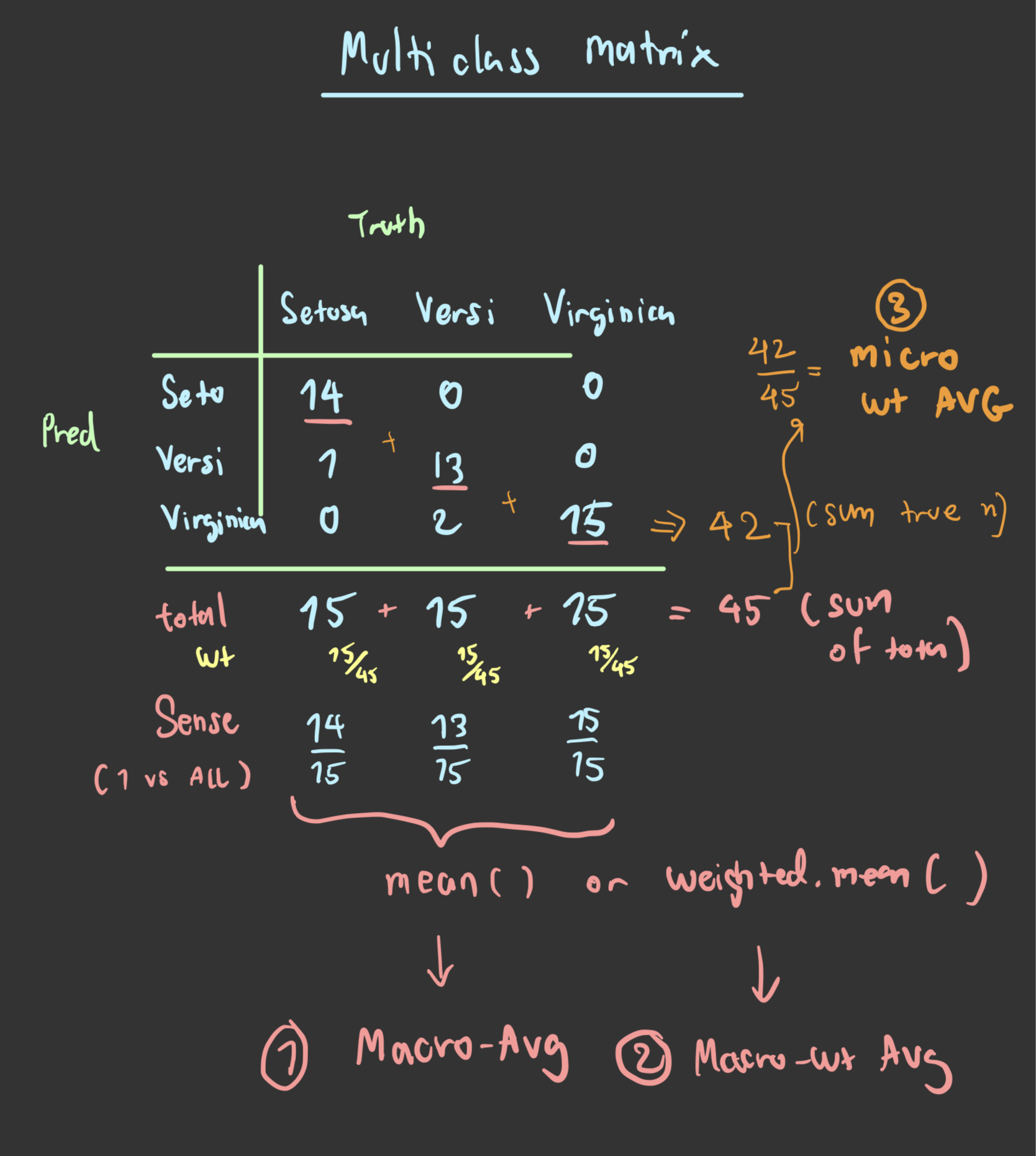set.seed(1)
iris_split <- initial_split(iris, prop = 0.7, strata = Species)
iris_tr <- training(iris_split)
iris_tst <- testing(iris_split)Multi-class Performance Matrix
Pre-processing
Recipes
iris_rec <- recipe(Species ~ ., data = iris) Model Spec
multinom_sim <- multinom_reg(engine = "nnet")Workflow
iris_wf <- workflow(iris_rec, multinom_sim)Fit & Predict
Fit Model
iris_fit <- fit(iris_wf, data = iris_tr)
iris_fit══ Workflow [trained] ══════════════════════════════════════════════════════════
Preprocessor: Recipe
Model: multinom_reg()
── Preprocessor ────────────────────────────────────────────────────────────────
0 Recipe Steps
── Model ───────────────────────────────────────────────────────────────────────
Call:
nnet::multinom(formula = ..y ~ ., data = data, trace = FALSE)
Coefficients:
(Intercept) Sepal.Length Sepal.Width Petal.Length Petal.Width
versicolor 53.35203 3.845927 -31.93694 10.02870 -3.275975
virginica -57.85131 -23.541980 -41.71563 61.61759 31.272313
Residual Deviance: 0.1554973
AIC: 20.1555 Predict
iris_res <- broom::augment(iris_fit, new_data = iris_tst)
head(iris_res)# A tibble: 6 × 9
Sepal.Length Sepal.Width Petal.Length Petal.Width Species .pred_class
<dbl> <dbl> <dbl> <dbl> <fct> <fct>
1 4.9 3 1.4 0.2 setosa setosa
2 5 3.6 1.4 0.2 setosa setosa
3 5.4 3.7 1.5 0.2 setosa setosa
4 4.8 3 1.4 0.1 setosa setosa
5 5.7 4.4 1.5 0.4 setosa setosa
6 5.4 3.9 1.3 0.4 setosa setosa
# ℹ 3 more variables: .pred_setosa <dbl>, .pred_versicolor <dbl>,
# .pred_virginica <dbl>Multi-class Performace Matrix
Confusion Matrix
conf_mat(iris_res, truth = Species, estimate = .pred_class) Truth
Prediction setosa versicolor virginica
setosa 14 0 0
versicolor 1 13 0
virginica 0 2 15Count number of observed class
class_totals <- iris_res |>
count(Species, name = "totals") %>%
mutate(class_wts = totals / sum(totals))
class_totals# A tibble: 3 × 3
Species totals class_wts
<fct> <int> <dbl>
1 setosa 15 0.333
2 versicolor 15 0.333
3 virginica 15 0.333cell_counts <-
iris_res %>%
group_by(Species, .pred_class) %>%
count() %>%
ungroup()
cell_counts# A tibble: 5 × 3
Species .pred_class n
<fct> <fct> <int>
1 setosa setosa 14
2 setosa versicolor 1
3 versicolor versicolor 13
4 versicolor virginica 2
5 virginica virginica 15# Compute the four sensitivities using 1-vs-all
one_versus_all <-
cell_counts %>%
filter(Species == .pred_class) %>%
full_join(class_totals, by = "Species") %>%
mutate(sens = n / totals)
one_versus_all# A tibble: 3 × 6
Species .pred_class n totals class_wts sens
<fct> <fct> <int> <int> <dbl> <dbl>
1 setosa setosa 14 15 0.333 0.933
2 versicolor versicolor 13 15 0.333 0.867
3 virginica virginica 15 15 0.333 1 # Three different estimates:
one_versus_all %>%
summarize(
macro = mean(sens),
macro_wts = weighted.mean(sens, class_wts),
micro = sum(n) / sum(totals)
)# A tibble: 1 × 3
macro macro_wts micro
<dbl> <dbl> <dbl>
1 0.933 0.933 0.933- Macro-averaging: computes a set of one-versus-all metrics using the standard two-class statistics. These are averaged.
- Macro-weighted averaging: does the same but the average is weighted by the number of samples in each class.
- Micro-averaging: computes the contribution for each class, aggregates them, then computes a single metric from the aggregates.
